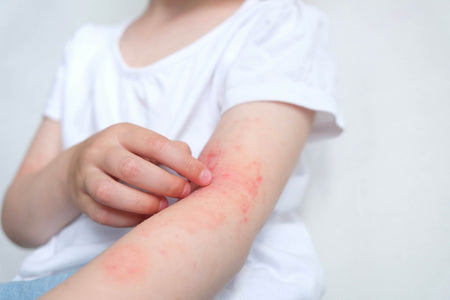- Cities with high pollen grades include Virginia Beach and Dallas.
- Cities with high allergy scores include Wichita and Virginia Beach.
- Residents and visitors should take extra precautions, such as checking local pollen forecasts, coming prepared with symptom-relief treatment, and managing indoor air quality.
Seasonal allergies are indeed quite common, with a significant number of individuals affected in the United States. According to the CDC, approximately 26% of U.S. adults have seasonal allergies, which are often triggered by pollen from trees, grasses, or weeds and occur during specific times of the year [*].
Certain areas can be more challenging for those with seasonal allergies due to higher pollen counts and other geographical, topographical and environmental factors. In this article, we list the most common places where pollen levels tend to be higher.
If you live in these areas or are planning to visit, it’s important to take extra precautions to control your symptoms effectively.
10 Worst Cities for Seasonal Allergies in 2025
Please note that the allergy score refers to the overall severity of allergy symptoms based on current pollen levels and personal sensitivity, while the pollen grade indicates the concentration of pollen in the air, ranging from average to worse than average.
Below is a summary of cities often cited as being tough on allergy sufferers:
| City | State | Allergy Score | Pollen Grade |
| Wichita | Kansas | 100 | Average |
| Virginia Beach | Virginia | 87.43 | Worst than average |
| Greenville | South Carolina | 87.34 | Average |
| Dallas | Texas | 87.21 | Worst than average |
| Oklahoma City | Oklahoma | 86.83 | Worst than average |
| Tulsa | Oklahoma | 86.35 | Worst than average |
| Richmond | Virginia | 84.20 | Average |
| Des Moines | Iowa | 84.15 | Average |
| Raleigh | North Carolina | 84.03 | Average |
| Fayetteville | Arkansas | 82.93 | Average |
1. Wichita, Kansas
Wichita, Kansas, is considered one of the worst cities for allergy sufferers due to its high levels of pollen from a variety of sources, including trees, grasses, and weeds.
The region experiences significant seasonal variations, with particularly severe pollen counts in spring and fall. Additionally, Wichita's location in the central U.S. exposes it to airborne allergens carried by winds, exacerbating the allergy season for residents.
Allergy Score: 100
Pollen Grade: Average
2. Virginia Beach, Virginia
Virginia Beach, Virginia, is a challenging city for allergy sufferers due to its high pollen levels, particularly from trees, grasses, and weeds that thrive in its humid, coastal climate.
The combination of significant seasonal pollen peaks and the city's proximity to both land and water contributes to elevated allergen counts. Additionally, the region’s mild winters and long growing seasons extend the duration of allergy symptoms.
Allergy Score: 87.43
Pollen Grade: Worst than average
3. Greenville, South Carolina
Greenville experiences significant tree pollen, especially from species like oak, pine, and birch. These trees release large amounts of pollen in the spring, which contributes to elevated allergy levels. Grasses such as Bermuda and Timothy produce high pollen counts in the warmer months.
The mild winters and humid conditions in Greenville create an environment conducive to prolonged pollen seasons. The humidity can also exacerbate symptoms by making pollen particles more likely to stick to surfaces, including indoor spaces.
Allergy Score: 87.34
Pollen Grade: Average
Related: Allergy Season in South Carolina
4. Dallas, Texas
Dallas, Texas, is a tough city for allergy sufferers due to its high pollen levels, particularly from trees like cedar, oak, and ragweed, which peak during both spring and fall.
The city's climate, characterized by hot, dry periods and occasional heavy rains, can exacerbate pollen dispersal and mold growth. Additionally, the combination of urban pollution and fluctuating weather patterns further aggravates allergy symptoms for residents.
Allergy Score: 87.21
Pollen Grade: Worst than average
5. Oklahoma City, Oklahoma
Oklahoma City, Oklahoma, is particularly challenging for allergy sufferers due to its high pollen levels from trees, grasses, and weeds, which are exacerbated by the area's strong winds and frequent dust storms.
The city's climate features hot, dry conditions that can lead to increased pollen dispersion and airborne allergens. Additionally, the extended allergy season caused by the region's variable weather patterns makes it a tough environment for those with seasonal allergies.
Allergy Score: 86.83
Pollen Grade: Worst than average
Related: Allergy Season in Oklahoma
6. Tulsa, Oklahoma
Tulsa, Oklahoma, is a difficult city for allergy sufferers due to its high levels of pollen from trees, grasses, and weeds, combined with the region's strong winds that can spread allergens over large areas.
The city's climate features hot, dry periods and frequent dust storms, which exacerbate allergy symptoms. Additionally, Tulsa's long allergy season, marked by significant seasonal pollen peaks and fluctuating weather, makes managing allergies particularly challenging.
Allergy Score: 86.35
Pollen Grade: Worst than average
7. Richmond, Virginia
Richmond, Virginia, is tough for allergy sufferers due to its high pollen levels from trees, grasses, and weeds, which are exacerbated by the region's humid, temperate climate.
The extended pollen season, with significant peaks in spring and fall, along with the area's frequent rainfall fostering mold growth, creates an environment where allergy symptoms are often severe and persistent.
Allergy Score: 84.20
Pollen Grade: Average
8. Des Moines, Iowa
Des Moines, Iowa, poses significant challenges for allergy sufferers due to its high pollen counts from trees, grasses, and weeds, which are prevalent in the region's climate.
The city experiences distinct seasonal changes, with peak pollen levels in spring and fall, combined with fluctuating weather patterns that can exacerbate symptoms. Additionally, Des Moines' humid conditions contribute to mold growth, further aggravating allergy issues for residents.
Allergy Score: 84.15
Pollen Grade: Average
9. Raleigh, North Carolina
Raleigh, North Carolina, is particularly tough for allergy sufferers due to its high pollen levels from a variety of sources, including trees, grasses, and weeds.
The city’s mild, humid climate and extended growing seasons lead to prolonged and intense allergy seasons, with peak pollen counts in spring and fall. Additionally, Raleigh’s frequent rainfall promotes mold growth, which further exacerbates allergy symptoms for residents.
Allergy Score: 84.03
Pollen Grade: Average
Related: Allergy Season in North Carolina
10. Fayetteville, Arkansas
Fayetteville experiences significant tree pollen, particularly from species such as oak, pine, and hickory. These trees contribute to high pollen levels during the spring. During the summer months, grass pollen is prevalent. Species like Bermuda and Timothy grass are common.
Additionally, Fayetteville experiences regular rainfall, which supports mold growth both indoors and outdoors. Mold spores can add to the allergen load and worsen symptoms.
Allergy Score: 82.93
Pollen Grade: Average
Summary
You can still be affected by seasonal allergies regardless of where you live, although the severity and types of allergens can be different depending on your location. Knowing which cities or regions have higher pollen counts can be useful in anticipating your symptoms and managing them.
Take proactive steps, such as monitoring pollen forecasts, improving your indoor environment, and using the right medications to find relief during allergy seasons.
For those seeking a reliable solution to manage seasonal allergy symptoms like sneezing, itchy nose, stuffy nose, and post-nasal drip, consider Allermi Nasal Spray.
References:
- FastStats. (n.d.). Allergies and Hay Fever. https://www.cdc.gov/nchs/fastats/allergies.htm









